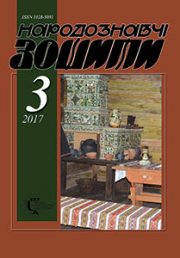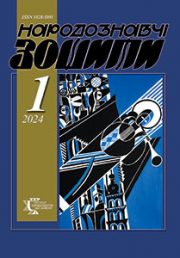The Ethnology Notebooks. 2019, № 6 (150), 1572—1582
UDK77.04:72.012.8(477.74)
DOI https://doi.org/10.15407/nz2019.06.1572
DMITRYUK Viktoriia
ORCID ID: https://orcid.org/0000-0002-3104-6787
Graduate of the Department of Archeology and Ethnology
Odesa I.I. Mechnikov National University
custodian of funds of the 2nd qual. categories
of the Odessa department
National Research and Restoration Center of Ukraine
7, Voznesensky lane, 65007, Odessa, Ukraine
e-mail: vik.vik.od.2018@gmail.com
Abstract. The article analyzes the transformation of the traditions of the use and functioning of photographs in the dwellings of the population of Odesa region for 150 years as an expressive component of folk life from the perspective of historical-anthropological approach. Changes in the typology of residential interiors have led to the active penetration of photographs into the living space of urban and rural residents. Observation was provided in a comparative perspective: the study was conducted among various settlements, individual ethnocultural, confessional and territorial groups of the region. Relevance of the topic: in the modern digital world, we observe an expansion of the range, a change in functions, shapes, as well as demonstrations of a traditional photo image. To study the regional specifics of the national visual thinking and culture of the multi-ethnic region of Odesa region, photographs should be introduced into the scientific circulation that reflect or are used for interior decoration of housing.
The author set the goal to investigate the functions of photographic images in the organization of a residential interior as a spatial domain on expeditionary materials of the Odesa region. The object of the study is the practice of using photographic images in urban and rural houses of Odesa region. The subject is photographs reflecting the existence of photographs in the interiors of Odesa region.
The source base was formed in the course of our own research trips, as well as as part of complex historical and ethnographic expeditions of the I.I. Mechnikov ONU during 2012—2019. The fixation was carried out using photographing and oral interviewing of respondents. Therefore, the basis of the work is the field materials of the author.
Keywords: photography in the interior, the functioning of photographic images in culture, the demonstration of visual images, photographic meanings and signs, the semantization of living space.
Received 25.11.2019
REFERENCES
Bayburin, A.K. (2005). Housing in the rites and performances of the Eastern Slavs. Moskva: Languages of Slavic culture [in Russian].
Peirce, Ch. (2000). The beginning of pragmatism. St. Petersburg: Laboratory of Metaphysical Studies Faculty of Philosophy St. Petersburg State University; Aleteia [in Russian].
Bayburin, A.K. (1981). The semiotic status of things and mythology. Material’naja kul’’tura i mifologija (Vol. 37). Leningrad: Nauka [in Russian].
Lotman, Ju. (1970). The structure of the literary text. Moskva [in Russian].
Razumova, I.A. (2001). Secret knowledge of the modern Russian family. Gen. Folklore. Story. Moskva: Indrik [in Russian].
Boytsova, O. (2013). Amateur photos: visual culture of everyday life. St. Petersburg: Publishing House of the European University in St. Petersburg [in Russian].
Petrova, A.A. (2010). Photographic practices of the northern village: the visual canon and communicative potential. Retrieved from: http://cmb.rsuh.ru/article.html?id=254914 (date of appeal: 14.11.2019 [in Russian].
Prigarin, O.A. (2011). Photos as a source for the study of the Old Believers of the Izmail diocese. Old Believers: history, culture, modernity. Materials of the X International Conference (Vol. 2, pp. 396—409). Moscow: Borovsk [in Russian].
Kolyastruk O.A. Use of visual sources in the reproduction of everyday life. Retrieved from: /http://www.nbuv.gov.ua/portal/natural/Nvuu/Ist/2008_21/028.htm (дата звернення: 14.11.2019) [in Ukrainian].
Berdzher, D. (2014). Photography and its purpose. Retrieved from: http://e-libra.ru/read/366253-fotografiya-i-ee-prednaznacheniya.html (дата звернення: 14.11.2019) [in Ukrainian].
Kazakevich, G. (2017). Visualizing Ukraine: amateur photography in Kiev at the turn of the 19th—20th centuries. Actual problems of social sciences and history of medicine, 4 (16), 68—72. Kyiv [in Ukrainian].
Moroz, A.B. (2013). Red corner without an icon. Mythological models and ritual behavior in the Soviet and post-Soviet space: Sat. articles (Pp. 117—125). Moskva: RSUH [in Russian].
Aksenov, V. (2008). Kill the icon: the visual thinking of the peasants and the functions of the royal portrait during the crisis of carnival culture 1914—1917. Etnіchna іstorіja narodіv Evropy: Zb. nauk. prac’ (Issue 26, pp. 386—409). Kyiv [in Russian].






